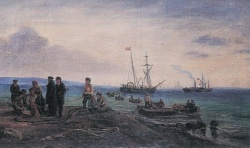A Quiet Start - but still a Success
01. Jan. 2004

Landing of the Great Belt cable on the island of Sprogø. Copy of painting by C.F. Sorensen, 1856. Among the sitting persons is Captain Lehman who is sending Denmark's first "submarine" telegram to Knudshoved. Post & Tele Museum.
People are Moved Closer Together
"I felt so strangely overwhelmed by the greatness of the invention; it was as if I stood underneath the flap of the wings of an immensely might spirit. I feel and see an infinite love of God also in each new glimpse of the laws of nature and the powers of nature which He thereby gives to mankind...
The material we gain [is], however, like timberwork erected for the building of the spirit; People are moved closer together, ideas are more easily exchanged, we shall become like one people, one state of spirit".
Thus wrote Hans Christian Andersen enthusiastically to his friends in 1853 when Peter Faber, director of the telegraph service, had demonstrated the first Danish telegraph line to him. The line had not yet been opened officially, but the stretch between Copenhagen and Elsinore had been completed and was used for training of telegraph operators.
The Sound Line
The first Danish telegraph line, the Sound Line, was to open on 1st February 1854. The line connected Elsinore with Hamburg and made Denmark part of the steadily growing European telegraph network. One might have expected the press to show great interest in the telegraph and the dawning revolution of communication. But no! On 30th January 1854 nothing but an official announcement of the opening was printed. The fact that the opening had to be postponed until 2nd February due to an earth slip between Haderslev and Aabenraa did not exactly inspire much respect

In 1871, Hans Christian Andersen expressed his fascination of the telegraph in his fairy-tale about the sea-serpent in which the fishes in the Atlantic reluctantly have to accept a new inhabitant, "The Great Sea-Serpent", the telegraph cable between England and America. Drawing by Lorenz Frölich.
Growing Pains
The telegraph had its growing pains: The line had been laid of underground cables. Although the cables were expensive and more burdensome than overhead lines, head of operations, Captain Lehman estimated that overhead cables would be too exposed to vandalism. However, it turned out that moisture often penetrated the buried cables and caused the connection to break down. Whenever that happened, it caused a lot of work i.e. to localize the leak, dig up the cable, and repair it.
The soft spot of the Sound Line was the Great Belt where a submarine cable had been laid down in 1853. If it was damaged, repairs would take several weeks and during that time the telegraph would lose its greatest force: The speed. An accident occurred already two weeks after the opening. The anchor of a ship tore the cable apart and the line was dead for six weeks. Therefore it was an important task for director Peter Faber to improve the telegraph network. He had the underground cables replaced successively by overhead cables. But until 1860 when a spare cable was laid down under the Great Belt, telegraph operators had to keep their fingers crossed in the hope that exactly this part of the connection was not interrupted.
A Success
Despite the starting problems the telegraph soon became a success. Information which used to be several weeks on the way came in via the telegraph in very short time to the advantage of the press as well as commerce. The success led to demands for more telegraph lines from those who did not benefit from the Sound Line. In several towns they could not wait for the State Telegraph to extend its network, and consequently money was raised to establish private lines.
During the first 25 years the Danish telegraph network was extended from 530 km to 2800 km. The number of stations increased from nine to 200. The enthusiasm for the telegraph was not - as was the case with Hans Christian Andersen - based on philosophic contemplations regarding more international understanding, but on practical and profitable conditions, pure and simple. In order not to be left behind you had to take part in progress. And the telegraph was progress.
This article may be copied or quoted with MuseumsPosten, Post & Tele Museum as source.
Comment this article
Only serious and factual comments will be published.